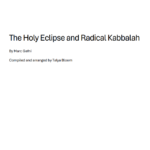On the Wounds of Love: Part Two – Marc Gafni
marc gafni
published on marcgafni.com
please share comments on info@marcgafni.com
Good evening. It is close to midnight here in Salt Lake. Just spent a wonderful evening with five goddesses. A group of friends, all powerful feminine spiritual teachers who are on the way to their annual retreat in the Utah desert. This is the third year that we have met here in Salt Lake before and after their retreat. Each one is a strong, vulnerable, audacious figure. Each one comes with her unique gifts of spirit. They are, each one of them, deeply good, smart, wild, giving, sexy, modest, wounded, provocative, profound, healing, outrageous, and gentle. In short, they are Incarnations of Shekinah, the feminine goddess divine.
It is with some of them, at different times, that I have over the past two years explored the wounds of love. It is they, together with my wonderful friend Dalit, who held me and challenged me, fought with me, supported me, and loved me as I loved them. I dedicate this sharing on the wounds of love to them.
On the Wounds of Love: Part Two
by Marc Gafni
posted on marcgafni.com
The way I will do an ongoing series of posts is to always start with the last couple of paragraphs from the previous post.
In Zen, there is a famous koan about a master who teaches by giving student a thorough beating. No matter what question the student asks, the beating comes just the same. When the student attempts to answer the question, he receives a beating. When the student remains silent, he gets a beating. When the student attempts to escape or withdraw, he still gets a beating. Eros often teaches like that Zen master, giving a complete knock-out, foot-to-groin, nose-smashed-against-asphalt pummeling. It demands that we experience pain, injury, and the collapse of self–even that we recognize suffering itself as its loving touch.
Our sexual and romantic lives are filled with an array of agonies not easily borne by the ego, by the body, or by the sense of (limited) self. There is the pain of not being seen or desired, and the pain of being seen starkly, in all of our most shame-inducing imperfections. There is the pain of not getting the affection we seek, or the pain of having it for a time, then losing it. There is the startling pain of realizing we were not our beloved’s only one–the fact that our beloved shared his love with others may cut into our desperately human need to be special. There is the pain of being asked for more than we are able to give, and the pain of trying to give and not being wanted. There is the pain of love which turns to hate, of affection which turns to contempt, and of the touch which, once desired, becomes repellent.
Then there is the pain of betrayal. Betrayal is uniquely excruciating because only someone whom you really trust–someone who could never, you thought, betray you–can deliver this particularly devastating blow.
Sex models life in that it hurts like hell. It’s no wonder that so much popular eroticism contains a twinning sex and pain, domination and submission. In sex, even with the best intentions, we often seem bound to inflict injury, and bound to receive it. We’re sure to be hurt in love, and we’re sure to hurt. We are subjected to injury against our will, and no matter how
hard we fight against it, we injure others all the time.
I don’t say this to be released of responsibility to others; ignorance, hubris, and grasping demand reckoning, and all
transgressions against others must be known for what they are. (And who among us is without transgression.) What I’m saying is that even genuine sensitivity, even a radical willingness to take
responsibility, even a vow to end suffering, does not take away pain.
As the Irish mystic rock singer Bono sings,
- “We’re one,
- but we’re not the same,
- You see, we hurt each other,
- then we do it again!”
Entering the Temple of Pain
So, even though a stiff drink of good Irish whisky might seem like the best response to the pain of eros, medicating our suffering never works for long. In the end, we have to be willing to look into pain deeply and directly. We need to know it first-hand, entering the interior of pain as we enter the interior of sex – with full presence, with a yearning to see, feel, and know it, and with a mind and heart expanded enough to embrace the whole catastrophe at once.
How does the hurt feel? What are its qualities? How do we engage the interiority of pain without violating our wholeness? How do we remain fully present to what is actually happening inside of us? How do we stay open in the midst of the pain, and even stay connected to the yearning that once animated our hearts? What is our pain telling us? If we could hear pain’s voice, what sacred wisdom might she whisper in our ear.
Before pain reveals her secrets, we need to become her lover. As with a lover, we need to attend to our responses to pain with the same care and discrimination that we give our pleasure.
What is our response to the feelings? What strategies arise to protect us against the experience of pain? Do we withdraw, attack and go to war, do we dull ourselves, do we immediately seek another love-fix, like the addicts we are?
What exactly is going on here?
Pain is a state of being. From a cognitive perspective, how we relate to the pain born of erotic or sexual betrayal is a decision. We choose the interpretive prism through which we will understand our pain, and that becomes the basis for our response to it. Sadly, we often use the prism of “I’m so hurt” to justify vengeful malice, either verbal or actual. We use our wounds as an excuse for hating an ex-lover or spouse, for seeking unwarranted financial or legal redress, for blackening their reputation. We twist the law to align with the twisted valves of our heart. Hurt becomes a free pass, a get-out-of-jail free card that we believe gives someone the right to take revenge. And of course, since malice cannot reveal it’s true
motivations, it must plead false ones, hiding behind masks of piety and noble intention.
Yes, all beings are hurt. We all carry some untransformed wound. But in the end we all must choose whether our wounds are to be allowed to fester in us, converted to malevolence, or transmuted into compassion. Suffering can lead us deeper into love or deeper into separation and hatred. It is always a choice. We each choose the prism for our pain, and the lens we choose is ultimately the mark of our level of consciousness.
For a young child or a person at a certain level of consciousness, rage and pain can seem like reason to kill. The great revelation of the Axial Age lawgivers is that wounded honor is not to be personally avenged in spilled blood–and as the Talmud reminds us, there are many ways to spill a person’s blood. Some of them are so subtle that the person doesn’t know he’s been stabbed. Others may drain the blood from a person’s face in such a way that it takes years to set things right.
To avoid translating pain into violence–whether physical, verbal, or imaginary–we need to pay close and unflinching attention to our interiority. We are required to clarify our pain through what a kabbalist might call the ten questions of Berur, the Clarification of Desire.
THE END
The next sharing On the Wounds of Love will be on the clarification of desire.
Note to Reader:
Just a little sharing about my education in blogs: I do not really know how to do this blog thing, but the advice I am getting is shorter blogs, which I have tried to do, and to find a template. So, if anyone has a template, please let me know.
Marc Gafni








